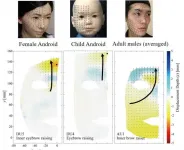(Press-News.org) A study by the Dian Fossey Gorilla Fund shows that gorilla families come together to support young gorillas that lose their mothers.
The findings, published in the journal eLife, use the Fossey Fund's more than 50-year dataset to discover how maternal loss influences young gorillas' social relationships, survival and future reproduction. The study shows when young mountain gorillas lose their mothers, the rest of the group helps buffer the loss by strengthening their relationships with the orphans.
"Mothers are incredibly important for survival early in life--this is something that is shared across all mammals," said lead author Dr. Robin Morrison. "But in social mammals, like ourselves, mothers often continue to provide vital support up to adulthood and even beyond."
"In many species, like our close relatives, chimpanzees, individuals without mothers suffer higher mortality or may be less successful parents themselves, and this finding can hold even if the loss occurs in early adulthood," she said. "But our research shows that mountain gorillas really go against this trend."
The study shows that gorillas whose mothers died or left their group after they were able to feed themselves but before they were fully mature (between the ages of two and eight), do not have any greater risk of dying than those whose mothers are still around. In addition, maternal loss does not appear to have any long-term effect on the young gorillas' eventual ability to produce and rear offspring themselves.
What does change, however, is the number of affiliative interactions they have with other group members, which increases dramatically after they are orphaned.
The authors suggest that this support from other group members may be similar to what we see in humans, where other family members and even non-relatives can step into key roles in caring for children.
Mountain gorillas live in close-knit "family" groups including a dominant silverback male who leads the group, multiple adult females, their immature offspring and, in some cases, subordinate adult males.
Male gorillas are known to care for young members of their group, regardless of paternity. In her lifetime, Dian Fossey noted, "The extraordinary gentleness of the adult male with his young dispels all the King Kong mythology"--an observation reinforced by this study, which found that the dominant silverback male plays a particularly important role in supporting young motherless gorillas, spending more time close to them and increasing the time spent resting and grooming together. This response is common across all group leaders whether or not they are the genetic fathers. Access to the highest-ranking individual likely ensures that orphans do not become socially isolated and continue to have access to food and other resources.
"These findings suggest that our capacity to care for other group and family members in times of need may be deeply rooted within our DNA and something we share with gorillas," said Morrison.
This research used data on the lives of mountain gorillas collected by hundreds of individuals going back to 1967, when Dian Fossey first established long-term monitoring of the gorillas.
"This study highlights the value of long-term research on wild animal populations" said Dr. Tara Stoinski, senior author on the study and CEO and chief scientist of the Dian Fossey Gorilla Fund.
"Just like us, gorillas live long lives, so it takes years for researchers to record the rare and fascinating behaviors that occur over a gorilla's lifetime. Our dataset, one of the longest of any animal species, stretches back more than 50 years, helping us understand how much we share with one of our closest relatives as we work to protect them and their biodiverse habitat."
INFORMATION:
For further information please contact:
Lead author: Dr. Robin Morrison, rmorrison@gorillafund.org
Dian Fossey Gorilla Fund press contact: Donna Gorman dgorman@gorillafund.org
About the Dian Fossey Gorilla Fund:
Established in 1967 by famed primatologist Dian Fossey, the Dian Fossey Gorilla Fund works to protect and study wild gorillas and their habitats and empower people who share the gorilla's forest home. With a team of more than 200 staff working in Rwanda and the Democratic Republic of the Congo, the Fossey Fund is the world's longest running and largest organization dedicated entirely to gorilla conservation. At the time Fossey began her groundbreaking work, it was predicted that mountain gorillas would be extinct by the year 2000. Instead, they are recognized as one of the world's few conservation success stories, and recently were moved from 'critically endangered' to 'endangered,' one step further from extinction.
The Fossey Fund's people-centered approach to conservation is focused on four pillars:
Protecting individual gorillas and their families;
Conducting critical science needed to develop conservation strategies;
Training future leaders to address the conservation challenges of the future;
Helping communities living near gorillas through livelihood, food security and education initiatives.
For more, visit: gorillafund.org. Follow us on Facebook, Twitter and Instagram @savinggorillas
Osaka, Japan - Researchers from the Graduate School of Engineering and Symbiotic Intelligent Systems Research Center at Osaka University used motion capture cameras to compare the expressions of android and human faces. They found that the mechanical facial movements of the robots, especially in the upper regions, did not fully reproduce the curved flow lines seen in the faces of actual people. This research may lead to more lifelike and expressive artificial faces.
The field of robotics has advanced a great deal over the past decades. However, while current androids can appear very humanlike at first, their active facial expressions may still be unnatural and slightly unsettling to us. The exact reasons ...
Although cancers that occur in the gallbladder or bile ducts are rare, their rates are increasing. A recent study provides details on the burden of gallbladder and biliary tract cancer (GBTC) across 195 countries and territories from 1990 to 2017. The findings are published early online in CANCER, a peer-reviewed journal of the American Cancer Society.
Determining GBTC estimates and trends in different global regions can help to guide research priorities and policies for prevention and treatment. With this in mind, a team of scientists examined publicly available information ...
Patient care by a single primary care physician is associated with many health benefits, including increased treatment adherence and decreased hospital admissions and mortality risk. But can the relationship built between doctor and patient also lead to unnecessary care?
A new University of Florida study finds that male patients who have a single general physician were more likely to receive a prostate cancer screening test during a period when the test was not recommended by the US Preventive Services Task Force. The study, which appears in END ...
When power stations burn coal, a class of compounds called Polycyclic Aromatic Hydrocarbons, or PAHs, form part of the resulting air pollution. Researchers have found that PAHs toxins degrade in sunlight into 'children' compounds and by-products.
Some 'children' compounds can be more toxic than the 'parent' PAHs. Rivers and dams affected by PAHs are likely contaminated by a much larger number of toxins than are emitted by major polluters, researchers show in Chemosphere.
A coal-fired power station and a cigarette have more in common than one might think. So do the exhaust pipes from cars and burning crop residues. The same is true for an aeroplane passing high over a wildfire ...
Human actions are threatening the resilience and stability of Earth's biosphere - the wafer-thin veil around Earth where life thrives. This has profound implications for the development of civilizations, say an international group of researchers in a report published for the first Nobel Prize Summit, a digital gathering to be held in April to discuss the state of the planet in the wake of the COVID-19 pandemic.
"Humanity is now the dominant force of change on planet Earth," according to the analysis published in Ambio, a journal of the Royal Swedish Academy of Sciences.
"The risks we are taking are astounding," says co-author Johan Rockström, director of the Potsdam Institute for Climate Impact Research and co-author of the analysis. "We are at the dawn of what must be a transformative ...
Study taken throughout the pandemic shows those who feel government should be less controlling believe COVID-19 poses less risk, which in turn was associated with the adoption of fewer protective behaviours
"A fearful population is not necessarily desirable... people may be underestimating or overestimating the actual risk at different times."
People's politics and values are exerting a bigger influence on how much of a threat they feel from COVID-19 compared to objective indicators such as the number of confirmed cases.
That's the finding of a new University of Cambridge survey which measured how attitudes to the coronavirus have varied over the course of 10 months of the pandemic for more ...
Hearing loss and other auditory problems are strongly associated with Covid-19 according to a systematic review of research evidence led by University of Manchester and NIHR Manchester Biomedical Research Centre (BRC) scientists.
Professor Kevin Munro and PhD researcher Ibrahim Almufarrij found 56 studies that identified an association between COVID-19 and auditory and vestibular problems.
They pooled data from 24 of the studies to estimate that the prevalence of hearing loss was 7.6%, tinnitus was 14.8% and vertigo was 7.2%.
They publish their findings in the International Journal of Audiology.
However, the team - who followed up their review carried out a year ago - ...
Scientists from the University of Leeds's Nutritional Epidemiology Group used data from 500,000 people, discovering that consuming a 25g serving of processed meat a day, the equivalent to one rasher of bacon, is associated with a 44% increased risk of developing the disease.
But their findings also show eating some unprocessed red meat, such as beef, pork or veal, could be protective, as people who consumed 50g a day were 19% less likely to develop dementia.?
The researchers were exploring a potential link between consumption of meat and the development of dementia, a health condition that affects 5%-8% of over 60s worldwide.
Their results, titled Meat consumption and risk of incident dementia: cohort study of 493888 UK Biobank participants, are published today in the American ...
WASHINGTON--One in five adults with type 1 diabetes who require in-hospital treatment of the life-threatening condition diabetic ketoacidosis has an unplanned repeat hospital visit within a month and is twice as likely to die during the second hospitalization, a new study finds. The results, which will be presented at ENDO 2021, the Endocrine Society's annual meeting, also identified several factors that increased the readmission risk for these patients.
Diabetic ketoacidosis, which can occur from insufficient insulin medicine or from an infection, is a dangerous accumulation of acid in the blood due to ...
WASHINGTON--A new once-weekly basal insulin injection demonstrated similar efficacy and safety and a lower rate of low blood sugar episodes compared with a daily basal insulin, according to a phase 2 clinical trial. The study results, which will be presented at ENDO 2021, the Endocrine Society's annual meeting, compared an investigational drug called basal insulin Fc (BIF) with insulin degludec, a commercially available long-lasting daily insulin, in patients with type 2 diabetes.
"These study results demonstrate that BIF has promise as a once-weekly basal insulin and could be an advancement in insulin therapy," ...

